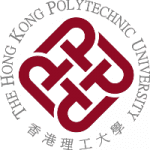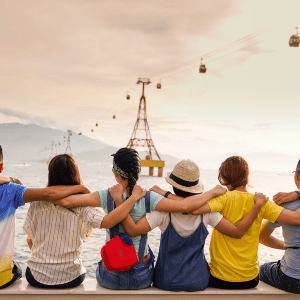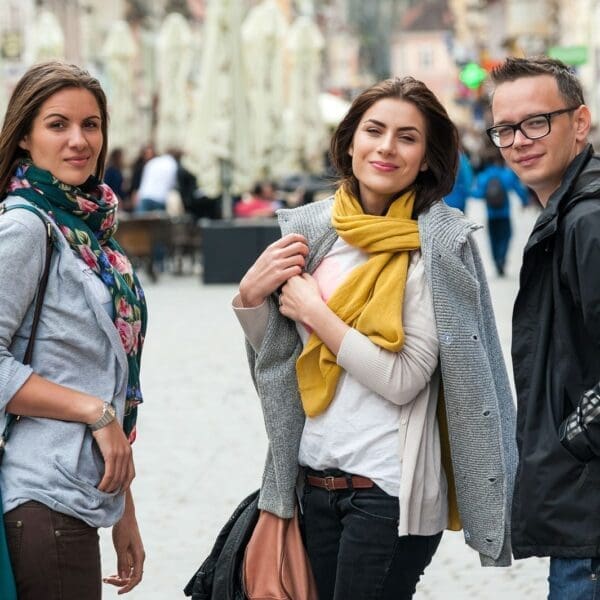 Whilst many tourists travel to experience new places, cultures and activities, others are visiting friends and relatives (VFR). VFR travel showed remarkable resilience during the COVID-19 pandemic, with many expats and immigrants returning to their countries of origin to weather the storm with loved ones. However, little is known about how pandemic-associated travel constraints were experienced by VFR tourists.
Whilst many tourists travel to experience new places, cultures and activities, others are visiting friends and relatives (VFR). VFR travel showed remarkable resilience during the COVID-19 pandemic, with many expats and immigrants returning to their countries of origin to weather the storm with loved ones. However, little is known about how pandemic-associated travel constraints were experienced by VFR tourists.
Dr Pearl Lin of the School of Hotel and Tourism Management (SHTM) at The Hong Kong Polytechnic University, working with co-researchers from Macao, have constructed an impressive new framework to pinpoint the travel constraints experienced by VFR travellers during the pandemic. This framework could help tourism practitioners alleviate such travel constraints and, in doing so, breathe fresh life into the industry.
VFR has been dubbed the “sleeping giant” of the tourism industry; it is a grossly overlooked motive for travelling. “Up to 48% of tourists worldwide travel for VFR purposes despite considering these trips leisure vacations, instead of self-identifying as VFR tourists”, report the researchers. VFR travel comes in three broad flavours – “pure” VFR tourists travel expressly to see friends and relatives, and lodge with them; “commercial” VFR tourists also come to see friends and relatives, but stay in hotels; while “exploitative” VFR tourists, although they stay with friends or family, do not state VFR as their trip purpose.
Given the ongoing neglect of VFR tourism in the literature, there is a clear need to better understand what makes VFR travellers tick and how VFR tourism benefits the industry as a whole. We already know that personal relationships are pivotal to VFR travel. “This market segment is primarily motivated by family/friend bonds”, say the researchers, “instead of destination attributes”. The specific benefits of VFR, in contrast with business or leisure travel, include revitalising local communities and increasing residents’ quality of life. Connections with local communities and strong personal ties could also explain why VFR travellers often visit their places of origin after natural disasters or other crises.
VFR travel seems more robust to tourism crises and economic downturns than other market segments, perhaps due to its emotional driving force. Crises might even spur VFR travel, as was reported after Australia’s Katherine region suffered a major flood in 1997. “VFR travellers are connected to communities that need emotional support rather than simply functional support”, explain the authors. “Relatedly, research conducted in 2017 recommended this tourist segment as a marketing focus to help destination management organisations revitalise the tourism industry during and after disasters”. The researchers were therefore eager to examine the needs of VFR travellers to understand the particularities of this market segment and cater better to their needs in the future.
The COVID-19 pandemic placed unprecedented constraints on international movement, stifling global tourism. Along with wide-ranging restrictions on their inbound and outbound travel, travellers faced health-related risks and various psychological, economic and social challenges. “COVID-19 complicated travel- and leisure-related decisions more than ever”, report the authors. During that trying time, strict border controls and other travel restrictions made leisure and business travel infeasible, sparking a tsunami of travel cancellations.
Marching bravely on, however, was VFR travel. Despite the difficulties and risks associated with travelling during the pandemic, many VFR tourists chose to batten down the hatches with loved ones in their overseas countries of origin. Meanwhile, many companies, such as Google, encouraged their international expat employees to work from home, further encouraging home-bound travel. “VFR trips thus potentially reflect the only form of travel that continues to support the tourism industry”, say the authors. These trips might not seem equivalent to a joyful reuniting of friends and family, but staying with loved ones while engaging with the host-country community mimics “exploitative” VFR travel, as these travellers do not use hotels but do contribute to local life and economy.
If VFR travel is indeed propping up an industry in crisis, then all efforts must be made to support this crucial branch of tourism in the wake of the pandemic. “Despite the prominence of VFR travel and its strong resilience in the face of global crises, it has been one of the most underexplored tourism contexts in the literature”, say the researchers. “We therefore examined the travel constraints of VFR travellers during the pandemic to enrich this tourism context”. The COVID-19 context offered a unique opportunity to examine VFR travel constraints in more depth and use these findings to lessen barriers to travel and help the industry get back on its feet.
The researchers set out to discover which travel constraints were experienced by VFR travellers during the pandemic period. They focused on expat workers who were originally from Taiwan (the “tourist-receiving country”). An estimated 2 million Taiwanese people were living abroad in 2019, making it an ideal context in which to study VFR travel. Armed with 167 online posts and 8,403 online comments from a private Facebook group for overseas Taiwanese, the authors conducted a thematic analysis to understand the lived experiences of these VFR travellers from “tourist-generating countries”.
Based on their analysis, the researchers classified the constraints faced by VFR travellers during the pandemic. Rather than considering these travel constraints in terms of their “nature”, the researchers categorised them according to their “root cause”. From this unique and fresh outlook emerged a framework with two distinct domains: an individual–family–community continuum and a tourist-generating country–tourist-receiving country continuum. Fourteen travel constraints were identified along these two continuums. For example, a fear of disturbing other house occupants while staying with friends or relatives in Taiwan is a family-level constraint in the tourist-receiving country.
Each intersection along the two continuums was associated with specific travel constraints. For example, individuals who made travel decisions based on their personal needs in the tourist-generating country were concerned about job requirements, high travel costs and the extent of pandemic control in their country of residence. In terms of the tourist-receiving country (Taiwan), inconvenient travel policies, high infection risk and misgivings about local circumstances were the major individual-level barriers to travel. “Destination management organisations should passively ease travel constraints for VFR travellers”, propose the researchers. “Such marketing strategies are likely to be effective because VFR travellers tend to be more willing to support these destinations’ economic recovery”.
In terms of the tourist-receiving country, disturbing others and feeling unwelcome were the major family-level constraints on VFR travel; in terms of tourist-generating countries, the family-level constraints most commonly experienced were the need for a stable living situation and homelike feeling. That is, VFR travellers during the pandemic were motivated by the idea of their home country as a safe haven, especially if their living circumstances as expats were unstable. “Travel agents could invite VFR hosts to write blogs about the tourist-receiving country’s pandemic status and express willingness to welcome VFR tourists”, recommend the authors. “Doing so can link VFR travel with social cohesion and happiness while maintaining communication with prospective visitors”.
Finally, community-related barriers to VFR travel included a sense of responsibility to the tourist-generating country, the possible decision to settle there permanently and a sense of responsibility to protect the world as a whole from the global pandemic. Tourism businesses could find great value in these results, especially as VFR tourism constraints relate to both tourist-generating and -receiving countries. “Our framework allows for a clearer understanding of how each travel constraint can be overcome”, say the authors.
Innovative ideas for promoting and rejuvenating tourism are much needed following the difficult COVID-19 period. By unearthing new insights from the pandemic period, destination managers and businesses can make proactive efforts to reduce VFR travel constraints in the post-pandemic landscape of tourism. In turn, this will help boost VFR travel.
“Clearly identified VFR travel constraints can help destination management organisations promote VFR tourism by reducing these barriers in the post-pandemic tourism industry”, conclude the researchers.
About the authors
Lin, Pearl M.C., Peng, Kang-Lin and Au, Wai-Ching (2022). To Return or Not to Return? Identifying VFR Travel Constraints during the Pandemic. Journal of Travel & Tourism Marketing, Vol. 39, Issue 1, 18-30.
















